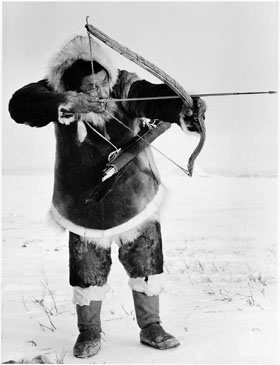Caribou hunting was and is still an important means of subsistence for many Indigenous people in Canada. Caribou are hunted by groups from the Arctic, Subarctic, Plateau, and the northern part of the Eastern Woodlands. In the past, the animals not only provided these people with meat and grease, but also with hides and sinew for shelters and clothing, and bone and antler for tools and weapons.
Traditional Practices
Indigenous people used to hunt caribou in different ways. Some animals were caught in snares or deadfalls. Hunters also stalked and killed caribou with the bow and arrow. In the Arctic and Subarctic regions, some groups took advantage of the caribou migration; they waited for the animals to cross a river and speared them from their canoes or kayaks.
This was the case at Fall Caribou Crossing on the lower Kazan River, Nunavut. The place was declared a National Historic Site in 1995; it commemorates the importance of the fall hunt at water crossings to the Kivallirmiut (Caribou Inuit) of Baker Lake. The Vuntut Gwitch’in also hunted caribou at crossings along the Porcupine River in the spring and summer. Klo-kut and Rat Indian Creek are two hunting camps located at crossings that were used during the late prehistoric (900 BCE-1850 CE) and early historic periods.
Another method for securing large quantities of caribou meat was the caribou fence, also known as corral or pound. Close to 50 caribou fences have been identified in Alaska, the Yukon and the Northwest Territories. Although no remains have been found in northern Quebec and Labrador, we know that caribou fences were used there through the Innu oral tradition. (See also Indigenous Oral Histories and Primary Sources.)
Caribou fences were major constructions that required the collaboration of several families. They were made with logs, brush or rocks. The fences were many kilometres long and were built in a V-shape with a corral at the narrow end. People scared the caribou to drive them into the fence. Once in the corral, the animals were either speared or caught in snares that were set in openings. The Thomas Creek Fence in the Vuntut National Park is a well-documented caribou fence.
Caribou Hunting Today
Following the arrival of the Europeans to their areas, Indigenous people gradually abandoned their traditional hunting methods for the rifle. Caribou hunting remains very important to them as a tradition. Moreover, it is an important source of food because they enjoy it and also because of the high cost of imported food in northern communities. Today, caribou hunting is also practised as a sport by non-Indigenous people; outfitters offer caribou-hunting expeditions to northern Canada and non-resident licences are offered by some provinces and territories.

 Share on Facebook
Share on Facebook Share on X
Share on X Share by Email
Share by Email Share on Google Classroom
Share on Google Classroom













